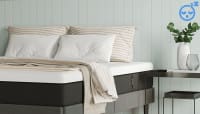History of the memory foam mattress, Guide, 2022

Memory foam was invented in 1966, but the main foam materials used for it, date back to 1937, when the potential for polyurethane was realized and before polyurethane was starting to be mixed with certain agents in the 1950s.
Together we’ll deep-dive into the origin of memory foam to see how it has changed.
How it started in space
Charles Yost is the man credited with the invention of memory foam, who was an aeronautical engineer. However, initially, it was not designed for beds.
Yost was contracted by NASA and his objective was to improve the cushioning of the seating in spacecrafts. The idea was that the astronauts in the spacecraft would be given more support than was available before against high-pressure G-force which they would be subjected to as they were launched out beyond the atmosphere and into space. At this time it was referred to as slow-spring back foam for obvious reasons and was not approved for usage down on earth until it passed the test that was partly conducted in space. In fact, a lot of memory foam mattresses still boast the ‘certified space technology’ stamp which is primarily placed on a product that uses technology developed for space programs.
How it was received
Memory foam was developed and grew in the U.S.A, but it was used for lining high-performance shoes, x-ray tables and lining for American football helmets before it found its way into mattresses. It was in 1974 that Charles Yost sold the memory foam formula for usage in American football.
He was able to cash in on it because the formula for the technology belonged to Charle Yost and he had started his own company after his invention of the special foam. NASA eventually released the formula to the public domain in the 80s. However, its introduction to the general public did not amount to instant popularisation. The memory foam which by this point was being called Dynofoam was difficult to manufacture and the production results sometimes left a lot to be desired.
Lift-off for the memory foam
In the 1980s a Swedish company called Fagerdala World foams decided that they would work with the technological blueprint and use it in the production of their mattresses which previously had been composed of polyurethane materials that did not have the viscoelasticity of memory foam. This company played with and developed the formula for about 10 years. Finally, it was ready. In 1991 the Tempur-pedic Swedish mattresses were released. This was really when it started to pick up in popularity with the sleeping benefits of memory foam becoming clear. Though other companies adapted the formula for memory-foam production it was the one used in the Tempur-pedic Swedish mattress which was the only to be recognized by NASA with the certified space technology stamp of approval with NASA still using it in modern-day space programs. Although the mattresses were getting more public attention, with more and more companies putting out their own take of memory foam, their consumption for a while was still stunted by how expensive they were due to the technology being used. Memory-foam mattresses of course became more popular when their pricing settled.

What the three generations of memory foam are
| Generation | History of generation of memory foam |
| First | The first form of memory foam was a polyurethane mixture with a gas being pumped into a polymer mold. Polyurethane would be mixed with water and sometimes hydrocarbons. First-generation memory foam was used as what was called inert polyurethane porous foam by members of the medical field who used it as padding for patients. It turned out that this memory foam padding prevented patients who were restricted to being on beds, from getting ulcers which commonly occurred from the pressure of lying down for a long time. It also prevented the growth of bacteria which was an important feature when used as a material for people where infections could be transmitted more catastrophically. |
| Second | They were designed to improve on the produced foam with an open-cell structure. This was performed as part of a process called vulcanization which basically was the chemical combination of rubber and sulfur at high temperatures. Second-generation memory foam was used for the safety of aircraft seating as the viscoelasticity was exceptional at the absorption of energy which increases the chance of someone’s survival in a crash. Also due to the four viscoelastic effects that allow the memory foam to have a slow conforming performance this was ideal for providing comfort to the astronauts who were involved in long space journeys. An example of memory foam being used to essentially its fullest is the Emma original. This could be what you’re after in a mattress. |
| Third | Even though the second generation memory foam made the cell structure of the foam more open which increased airflow and helped decrease heat within a mattress, memory foam was still known as getting unpleasantly hot. Therefore 40 years after Charles Yost’s breakthrough, the third generation of memory emerged. It was developed to combat the heat retention of the previous versions of memory foam and a combination of gel particles and foam was released as a new technology that successfully made mattresses cooler. Gel foam experienced an evolution of its own, but it is generally known as the latest iteration of the technology used in memory foam mattresses. To learn more about gel-foam mattresses and why they could be the ideal mattress purchase for you check out the link. |
In summary…
Knowing memory foam was initially tested out by astronauts and used in space makes it more reasonable to call their qualities out of this world and now if anyone tells you mattress-making is no rocket science you can politely correct them and cite this article as proof. Memory foam has many benefits and features which make it a wise purchase. It offers great padding along with pressure relief. This is due to the absorption and conformity qualities of viscoelasticity which made it ideal for seating safety in aircraft and cushioning for astronauts for spacecraft which illuminated the potential for its deployment in mattresses.

Also, the suitability for prolonged sleeping on a memory foam mattress is exemplified by how even the first generation memory foam was used to prevent pressured ulcers emerging on patients restricted to their beds. Much of a memory foam’s qualities are down to the open cell structure of the foam of which polyurethane is a crucial ingredient. Yet before concluding that memory foam is the mattress you’ll be going for, it is worth looking at the other kinds of foam available and how they compare with each other. To see this comparison, check out this link.
Get the sleep you deserve with our mattress and sleeping product reviews.
© Undercover Mattress 2022






